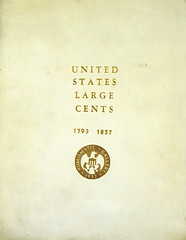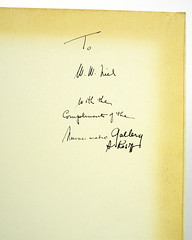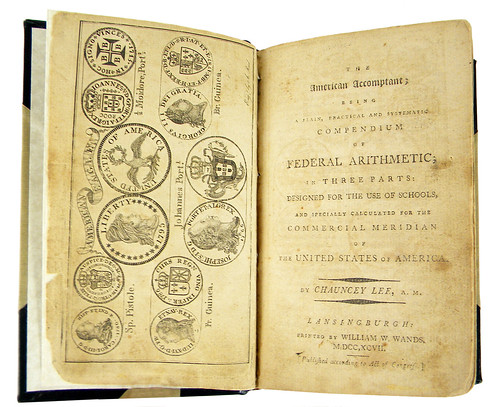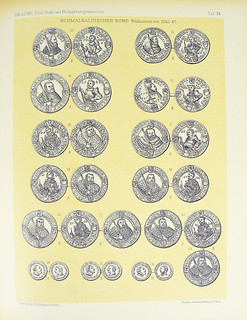
PREV ARTICLE
NEXT ARTICLE
FULL ISSUE
PREV FULL ISSUE
SELECTIONS FROM THE KOLBE & FANNING 2015 NEW YORK AUCTIONAt my request, David & Maria Fanning kindly forwarded these descriptions and photos of some lots that caught my eye in the
upcoming Kolbe & Fanning 2015 New York Book Auction. -Editor
Brause-Mansfeld on Siege Money
Ex Wayne Raymond, with his bookplate. A clean, fresh set of this great classic work on siege money, handsomely designed and printed. Rare and still indispensable. Clain-Stefanelli 16289*. Grierson 44. Mária & Lajos 227. A Consequential Misspelling?
  The Deluxe Leatherbound Edition. Inscribed in black ink on the front free flyleaf: “To W.W. Niel (sic) with the Compliments of the Numismatic Gallery, A. Kosoff.” An important catalogue, produced with the usual Kosoff flair. After listing 479 large cents of overall exceptionally fine quality and depicting both sides of 288 of them, Kosoff appended illustrated reprints of Crosby on 1793s and Chapman on 1794s. This famous catalogue is virtually unknown in the deluxe binding. The only examples we recall ever having seen are Sol Kaplan’s, sold in our October 17, 1992 Mendelson Library sale, and Homer K. Downing’s, sold in our June 1, 2004 Ford Library sale. Suave and debonair, Abe Kosoff carefully cultivated his best clients, hoping ultimately one day to handle their collections. Some of his competitors and contemporaries, perhaps in envy, are known to have termed him “the widow’s friend.” Will W. Neil’s outstanding collection of American coins was sold at auction three years after publication of the Pearl catalogue—not by Numismatic Gallery but by B. Max Mehl. In 1941, Kosoff had uncharacteristically misspelled his own name in an auction catalogue and, though it seems unlikely, one cannot help but wonder if this subsequent faux pas had consequences far more serious than the mere misplacement of a dot. Ex Kolbe Sale 111, lot 97. Ex Dave Steine library. First Known Appearance of the Dollar Sign in Print, and Earliest Known Illustration of a U.S. Coin
 280 Lee, Chauncey. THE AMERICAN ACCOMPTANT; BEING A PLAIN, PRACTICAL AND SYSTEMATIC COMPENDIUM OF FEDERAL ARITHMETIC; IN THREE PARTS: DESIGNED FOR THE USE OF SCHOOLS, AND SPECIALLY CALCULATED FOR THE COMMERCIAL MERIDIAN OF THE UNITED STATES OF AMERICA. Lansingburgh: Printed by William W. Wands, 1797. 12mo, modern green half calf, gilt; spine with five raised bands, ruled, lettered and decorated in gilt; two red spine labels, gilt. Frontispiece engraving of coins in current usage in the U.S. by A. Reed; 297, (15) pages. Marginal wear to frontispiece, on the blank recto of which is an original ownership inscription. Moderate browning. Very good or better in an attractive recent binding. (1500.00) This early American accounting and bookkeeping manual contains what is generally believed to be the first appearance in print of the dollar sign ($). It also includes, as a frontispiece, an engraving depicting a 1795 U.S. eagle, which Eric Newman has called “the earliest known illustration of a United States coin.” Also included on the engraving are the Spanish pistole, French “guinea,” British guinea, and Portuguese Johannes and half moidore. The book consists of a series of practical lessons for clerks. The dollar sign, which appears on page 56 for the first time and then throughout the volume, is a typographical approximation based upon the handwritten dollar sign used by some during the period. It resembles our own, but also differs from it. Much as a typographical ampersand is much more stylized than most of our handwritten ampersands, this initial attempt at a dollar sign in type is less a strict representation of the handwritten sign than an attempt to establish a similar sign for more formal treatment in type. A rare volume, of very high importance. For a fascinating overview of the history of the dollar sign, see Eric P. Newman’s “The Dollar $ign: Its Written and Printed Origin” in America’s Silver Dollars (New York: ANS, 1995). Evans 32366: “It is claimed that this work was the first to use the dollar mark, $.” Howes L196 (aa): “First book to adopt the dollar sign.” For more information on the sale, see:
Wayne Homren, Editor The Numismatic Bibliomania Society is a non-profit organization promoting numismatic literature. See our web site at coinbooks.org. To submit items for publication in The E-Sylum, write to the Editor at this address: whomren@gmail.com To subscribe go to: https://my.binhost.com/lists/listinfo/esylum All Rights Reserved. NBS Home Page Contact the NBS webmaster 
|
